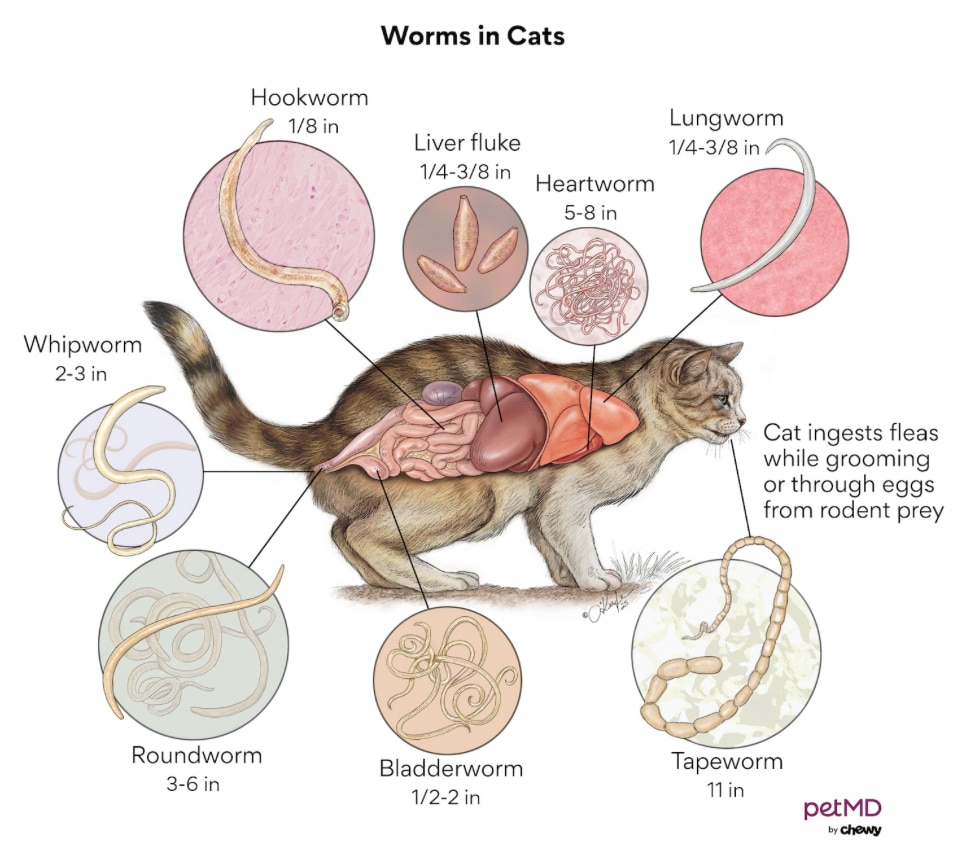Tapeworms in Cats
Christopher Freeman/iStock / Getty Images Plus via Getty Images
What Are Tapeworms in Cats?
If you let your cats go outside, there’s a good chance you’ll eventually have to deal with tapeworms. This is just one of the many reasons why it’s best to keep cats indoors.

Click here to download this medical illustration.
While these common intestinal parasites aren’t very dangerous for cats, they’re certainly gross.
Tapeworms can get large—common varieties can grow to be over a foot long—and when they reproduce, they shed portions of their body (called proglottids or tapeworm segments), which you might see in your cat’s feces, the fur around their hind end, or their favorite resting spots.
Symptoms of Tapeworms in Cats
Proglottids are the egg-containing segments of a tapeworm’s body. When they first come out of your cat’s anus, they look like pieces of white rice, and they may wiggle for a while.
Sometimes several tapeworm segments will be stuck together end-to-end. As they dry out, they become harder and more yellow than white.
Other than the presence of proglottids, most cats with tapeworms don’t have many other symptoms.
However, some possible symptoms of tapeworms in cats include:
In rare cases, intestinal blockage and signs of systemic disease such as a poor appetite, low energy, and weight loss can occur.
Causes of Tapeworms in Cats
There are three main types of tapeworms in cats, each of which infect cats differently.
-
The most common cat tapeworm is Dipylidium caninum. Cats get these tapeworms when they eat fleas containing immature forms of the parasite, usually when they are self-grooming in an attempt to rid themselves of fleas.
-
Cats get Taenia (also called Hydatigera) tapeworms when they hunt and eat infected prey, usually rodents.
-
Echinococcus tapeworms aren’t very common, but they can be transmitted to cats when they eat infected mice and squirrels.
How Veterinarians Diagnose Tapeworms in Cats
Veterinarians typically diagnose cats with tapeworms when they see proglottids around a cat’s hind end or in cat feces, or when a pet parent describes the proglottids they have seen at home.
Fecal flotation tests may reveal tapeworm eggs, but this is not as reliable as it is with other types of intestinal parasites like roundworms or hookworms.
Specialized testing that involves sending a fecal sample to a lab is often necessary if a veterinarian suspects that a cat may have echinococcus tapeworms.
Treatment of Tapeworms in Cats
Treating tapeworms in cats is fairly straightforward. Most veterinarians will recommend a medication called praziquantel. It's available in several forms.
By prescription:
-
Compounded oral liquids that are made in flavors cats love
-
Droncit™ tablets for cats
-
Liquids that can be absorbed through the skin, like Profender™ and NexGard® Combo
Over-the-counter (without a prescription)
-
Drontal™ tablets for cats
-
Elanco tapeworm dewormer for cats
Other medications such as epsiprantel, fenbendazole, or nitroscanate may be appropriate under certain circumstances.
Recovery and Management of Tapeworms in Cats
Most cats recover quickly after being treated for tapeworms.
Usually, the tapeworms will be broken down within a cat’s digestive tract, but if your cat has a lot of tapeworms, you may see some being expelled in their feces.
Side effects from tapeworm medications are rare. Call your veterinarian for advice if your cat acts sick in any way after being treated for tapeworms.
Keep in mind that while tapeworm medications are very good at getting rid of the tapeworms that a cat has at that time, they do nothing to prevent future infections.
Cats can get new tapeworms immediately after treatment, so prevention is vital.
Prevention of Tapeworms in Cats
Two forms of prevention are needed to stop cats from getting tapeworms:
-
Effective flea control: Dipylidium caninum tapeworms are spread through fleas. Therefore, flea prevention is necessary to prevent these tapeworms.
-
A good option for many cats is NexGard® Combo because it kills many types of cat parasites, including fleas, and also contains praziquantel as a backup measure for tapeworm prevention.
-
-
Stop hunting: Cats get taenia and echinococcus tapeworms through hunting. Keeping cats indoors is the best way to prevent them from getting these types of tapeworms.
If your cat has recurring problems with tapeworms, your veterinarian may recommend regularly giving your cat praziquantel or another deworming medication as a preventive measure.
Tapeworms in Cats FAQs
Are cat tapeworms contagious to humans?
Some cat tapeworms are contagious to humans. People can get Dipylidium caninum tapeworms if they eat infected fleas that their cats may carry. People can also get taenia tapeworms, but eating undercooked pork is usually the culprit, not cats.
A rare type of tapeworm called echinococcus is contagious to humans and can cause serious disease or even be fatal. Thankfully, echinococcosis, as the disease is called, is rare and not commonly associated with cats.
How do indoor cats get tapeworms?
Indoor cats can get tapeworms if they have fleas or hunt rodents within the house. Fleas can enter a home on other animals or even by temporarily hopping aboard people. They then have easy access to an indoor cat who isn’t being given a good flea preventive.
How do you treat tapeworms in cats at home?
Several over-the-counter medications are available that treat tapeworms in cats. Both Drontal™ tablets and Elanco tapeworm dewormer for cats are safe and effective, but it’s always best to talk to your veterinarian before giving your cat any medication.
